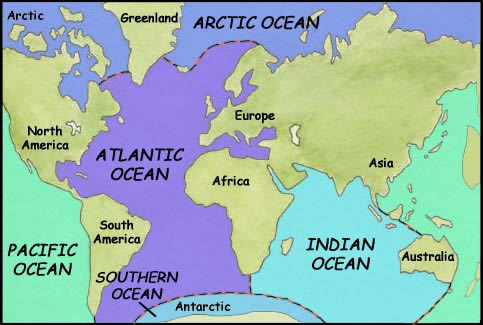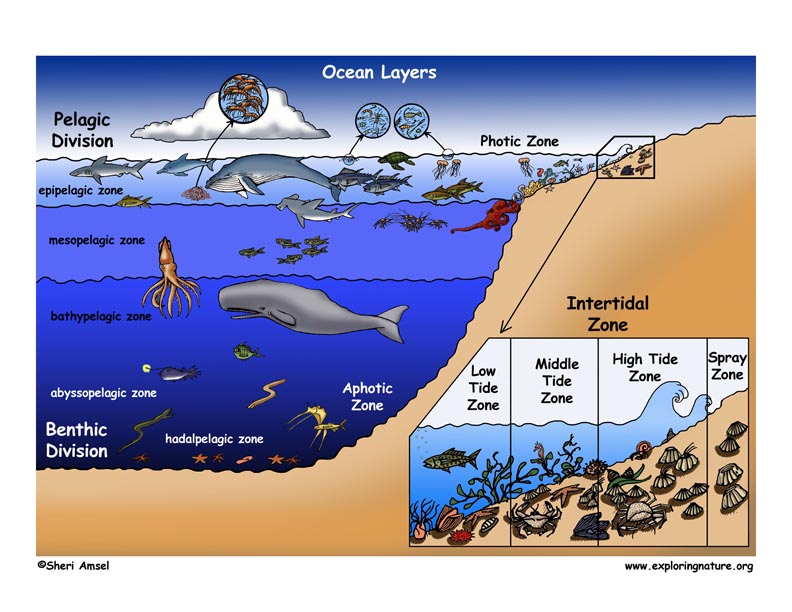

The oceans cover 75% of the Earth. They are all connected, but for the purpose of naming them they have been divided. The largest is the Pacific Ocean, then the Atlantic Ocean, the Indian Ocean, the Southern Ocean, and the Arctic Ocean. The Pacific Ocean stretches from the western side of North and South America across to Asia and north to south from the Arctic to the Antarctic. The Atlantic Ocean is found between the eastern coasts of North and South America and the western coasts of Europe and Africa. The Indian Ocean stretches from the east coast of Africa across to the west coast of Australia, including the Red Sea and Persian Gulf. The Southern Ocean encircles the continent of Antarctica. The Arctic Ocean includes a circular area surrounding the North Pole and is frozen solid much of the year.
Scientists break down the ocean in several ways. Physically, the ocean is divided into open water (the pelagic division) and the ocean floor (the benthic division.)
It is also divided into two major life zones. The coastal zone includes the shallow, warmer waters along the coast, full of nutrient-rich matter that supports life. The coastal zone covers everything from the high tide mark to the continental shelf. 90% of all ocean life lives in the coastal zone, though it makes up only about 10% of the ocean. It also is the most heavily used by humans for fishing and recreation, so is the most impacted by pollution and over use. The open sea includes the rest of the ocean away from land.
Lastly, the ocean is also divided into vertical zones (from top to bottom). The upper part of the ocean to 656 feet deep (200m) where sunlight can reach is the photic zone (or euphotic zone). Deeper than 656 feet it is dark. This is the aphotic zone (or abyssal zone). Between the two layers is a dimly lit zone called the bathyal zone.
The photic zone is where sunlight can reach the tiny phytoplankton algae (microscopic ocean plants) for photosynthesis -- the way plants make food from sunlight. Phytoplankton is the bottom of the food chain, giving food to small floating sea creatures (zooplankton) and small fish. From there, larger and larger sea animals can feed.
These vertical zones can be divided more specifically for study.
This top layer of the ocean is where most life is found. This photic zone of the pelagic division of the ocean is called the sunlight zone or epipelagic zone. The epipelagic zone has fish, whales, dolphins, and sharks. As you go deeper into the ocean it gets darker and the water pressure increases.
The next zone that goes from 656 feet to about 3,281 feet (1,000 m) is called the twilight zone or mesopelagic zone. There is very little light here, but many animals live here, including animals that make their own light (bioluminescent).
The next zone that goes from 3,281 feet to 13,124 feet (4,000 m) is called the dark zone or bathypelagic zone. No light reaches this zone, yet many animals are still found here. Besides for the glowing (bioluminescent) animals, sperm whales dive for squid at this great depth. They must be able to stand the very great water pressure at this depth.
The next zone that goes from 13,124 feet to 19,686 feet (6,000 m) is called the abyss or abyssopelagic zone. The water is very cold, dark and under extreme pressure at this depth. Very little life is found here, except for some kinds of squid, worms and sea stars.
The deepest zone that goes from 19,686 feet to 32,810 feet (10,000 m) is called the trenches or hadalpelagic zone. This depth is only found in deep ocean trenches. Even in these cold, dark places there are animals; like starfish and worms that survive.
There are a huge number and variety of animals that live in the ocean. There are countless species of fish. There are marine mammals; like whales, dolphins, seals, walrus, and manatees. There are crustaceans; like crabs, lobsters and barnacles. There are mollusks like; clams, mussels and octopus. There are also many kinds of sharks, sea turtles, jellyfish, anemones, star fish, corals and sting rays.
There are many kinds of plants in the ocean. The most important plant may be the smallest, phytoplankton. This microscopic algae floats on the ocean surface and uses sunlight to make energy through photosynthesis. Other plants include many kinds of seaweed, sea grass and kelp.
When you research information you must cite the reference. Citing for websites is different from citing from books, magazines and periodicals. The style of citing shown here is from the MLA Style Citations (Modern Language Association).
When citing a WEBSITE the general format is as follows.
Author Last Name, First Name(s). "Title: Subtitle of Part of Web Page, if appropriate." Title: Subtitle: Section of Page if appropriate. Sponsoring/Publishing Agency, If Given. Additional significant descriptive information. Date of Electronic Publication or other Date, such as Last Updated. Day Month Year of access < URL >.
Amsel, Sheri. "About the Oceans" Exploring Nature Educational Resource ©2005-2024. December 15, 2024
< http://www.exploringnature.org/db/view/1733 >

